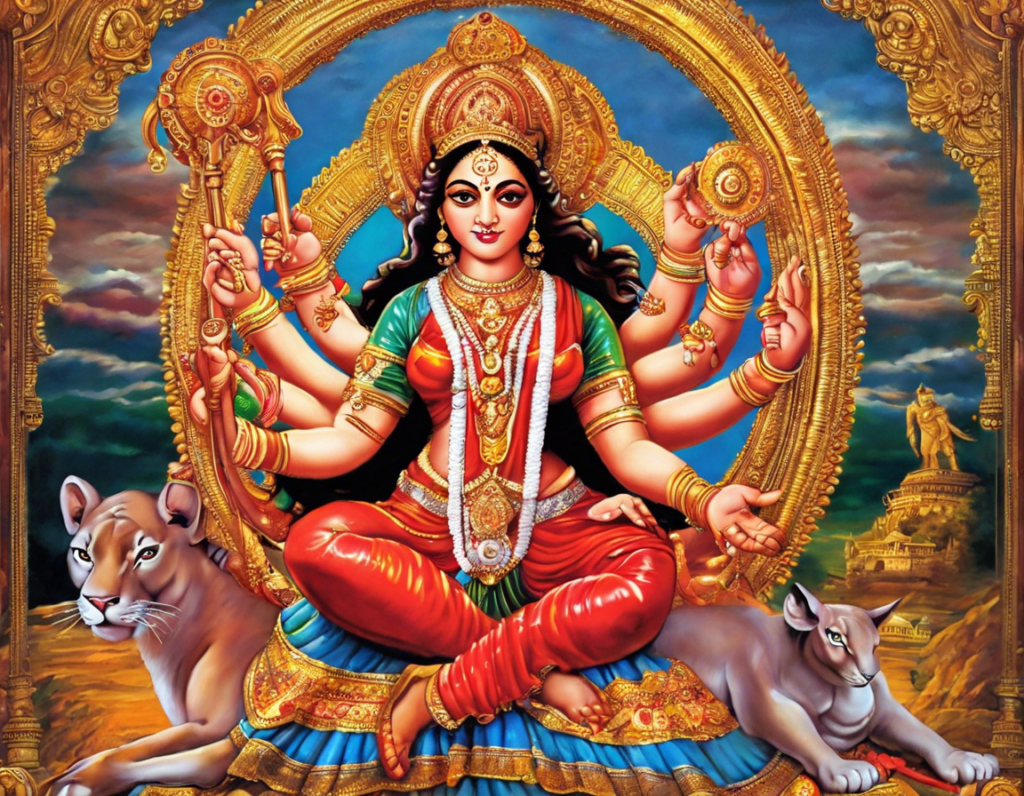India, a land rich in culture and spirituality, holds a prominent place for goddess worship. Among the revered deities, Durga Maa stands as a symbol of divine strength, courage, and protection. The embodiment of feminine power and resilience, Durga Maa is worshipped throughout the country with immense devotion and reverence.
Who is Durga Maa?
Durga Maa is a Hindu goddess known for her ferocious form and benevolent nature. She is often depicted riding a lion or tiger, wielding an array of weapons in her multiple arms. Durga Maa is considered the divine mother, protecting her devotees from evil and removing obstacles from their lives. She is also known as Mahishasuramardini, the slayer of the buffalo demon Mahishasura, symbolizing the victory of good over evil.
The Iconography of Durga Maa
Durga Maa is typically portrayed with eight or ten arms, each holding a different weapon to represent her divine strength and ability to combat all forms of negativity. She is adorned in magnificent attire and jewelry, signifying her royal lineage and supreme power. The image of Durga Maa radiates courage, fearlessness, and compassion, making her a beacon of hope for her devotees.
Significance of Durga Puja
One of the most popular festivals dedicated to Durga Maa is Durga Puja, celebrated with grandeur and enthusiasm across India. This multi-day festival honors the victory of Goddess Durga over Mahishasura and signifies the triumph of good over evil. During Durga Puja, elaborate pandals (temporary structures) are constructed to house beautifully crafted idols of the goddess, attracting devotees and visitors from far and wide.
The Rituals and Traditions
Devotees perform various rituals and ceremonies during Durga Puja to invoke the blessings of the goddess. They offer prayers, chant mantras, light incense, and perform aarti to express their devotion and gratitude. The festival is also marked by cultural programs, dance performances, and delicious feasts shared with family and friends. It is a time of joy, celebration, and spiritual renewal for all who participate.
The Divine Feminine Energy
Durga Maa represents the divine feminine energy that is present in all living beings. She is the epitome of Shakti, the cosmic energy that fuels the universe and empowers individuals to overcome challenges and adversities. By worshiping Durga Maa, devotees seek to harness her strength, courage, and wisdom to navigate life’s complexities and emerge victorious in their endeavors.
The Nine Forms of Durga
Durga Maa is worshipped in nine different forms during the festival of Navratri, each representing a unique aspect of her divine personality. These forms include Shailaputri, Brahmacharini, Chandraghanta, Kushmanda, Skandamata, Katyayani, Kalaratri, Mahagauri, and Siddhidatri. Each form symbolizes a specific quality or trait that devotees meditate upon to seek blessings and guidance from the goddess.
The Spiritual Teachings of Durga Maa
Beyond her role as a fierce warrior goddess, Durga Maa offers profound spiritual teachings to her devotees. She inspires them to confront their inner demons, face their fears with courage, and stand up against injustice and oppression. Durga Maa’s message is one of empowerment, self-discovery, and liberation from ignorance and ego, guiding her followers towards spiritual enlightenment and self-realization.
Embracing Durga Maa’s Strength
In the modern world filled with challenges and uncertainties, the worship of Durga Maa holds immense significance for individuals seeking inner strength and resilience. By connecting with the divine energy of Durga Maa, one can tap into their own potential, face obstacles with determination, and emerge stronger and wiser from life’s trials. Devotees of Durga Maa often experience a sense of empowerment, protection, and divine grace that sustains them through difficult times.
Conclusion
Durga Maa, the fierce and compassionate goddess, continues to inspire millions of devotees with her divine strength and protective presence. Through her worship and teachings, individuals find solace, courage, and guidance to navigate the complexities of life and emerge victorious in their spiritual journey. Embracing the divine essence of Durga Maa is not just an act of reverence but a profound transformational experience that awakens the inner warrior and nurtures the soul with divine love and wisdom.
FAQs
-
What is the significance of Durga Maa in Hindu mythology?
Durga Maa symbolizes divine strength, courage, and protection in Hindu mythology. She is revered as the goddess who defeats evil forces and safeguards her devotees from harm. -
How is Durga Maa worshipped during Durga Puja?
Devotees worship Durga Maa by offering prayers, performing rituals, chanting mantras, and conducting aarti ceremonies during Durga Puja. They also visit pandals to seek the blessings of the goddess. -
What is the spiritual significance of the nine forms of Durga during Navratri?
The nine forms of Durga worshipped during Navratri represent different aspects of her divine personality, offering devotees unique qualities and virtues to meditate upon and invoke in their lives. -
How can one connect with the divine strength of Durga Maa in daily life?
Devotees can connect with Durga Maa’s divine strength by chanting her mantras, meditating on her forms, practicing acts of compassion and courage, and seeking her guidance through prayers and offerings. -
Why is Durga Maa considered a symbol of feminine power and resilience?
Durga Maa embodies the divine feminine energy of Shakti, representing strength, courage, and compassion. She empowers individuals to confront challenges, overcome obstacles, and embrace their inner warrior spirit.
